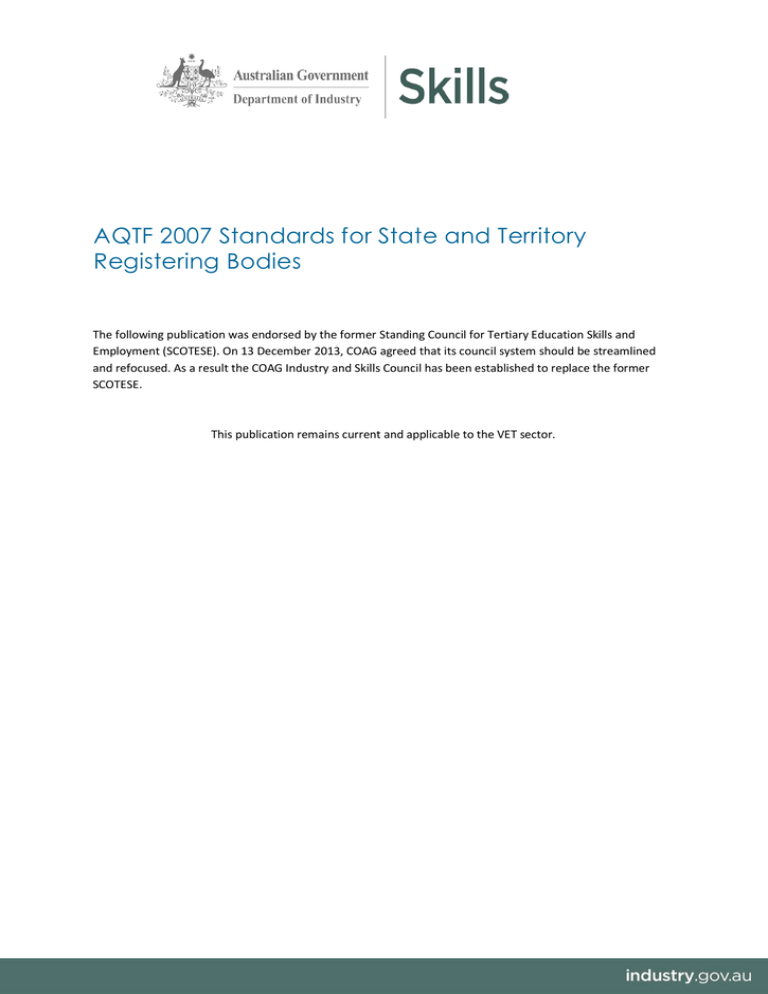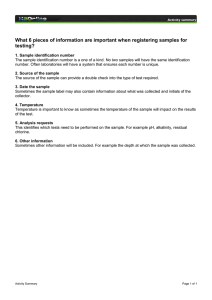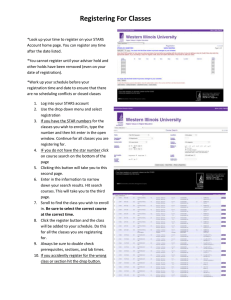
AQTF 2007 Standards for State and Territory
Registering Bodies
The following publication was endorsed by the former Standing Council for Tertiary Education Skills and
Employment (SCOTESE). On 13 December 2013, COAG agreed that its council system should be streamlined
and refocused. As a result the COAG Industry and Skills Council has been established to replace the former
SCOTESE.
This publication remains current and applicable to the VET sector.
Standards for
State and Territory
Registering Bodies
© Commonwealth of Australia June 2007
This work is copyright. It may be reproduced in whole or in part for study or training purposes,
subject to the inclusion of an acknowledgement of the source and provided that it is not used
for commercial use or sale. All rights are reserved. Reproduction for purposes other than those
indicated above requires prior written permission from the Commonwealth. Requests and enquiries
concerning reproduction and copyright should be addressed to the Branch Manager, Technology
and Information Services Branch, Industry Skills Development Group, Department of Education,
Science and Training, GPO Box 9880, Canberra City, ACT, 2601.
Introduction to AQTF 2007
The national training system is a key driver of Australia’s economic and social growth. For more than a
decade, Australian and state and territory governments have worked with industry to develop a national
training system that now provides the basis for high-quality, industry developed and nationally recognised
training to about one in nine working-age Australians. Through a national network of over 4,200 public and
private registered training providers, over 1.5 million Australians from all ages, backgrounds and locations
participate in vocational education and training each year.
The Australian Quality Training Framework (AQTF) is the national set of standards which assures nationally
consistent, high-quality training and assessment services for the clients of Australia’s vocational education and
training system. AQTF 2007 is the current version of the framework, effective from 1 July 2007.
The National Quality Council (NQC) collaboratively developed AQTF 2007 and will continue to monitor
it. The NQC includes all state and territory governments, the Australian Government, peak industry bodies,
peak training organisations and a representative on equity issues. The Ministerial Council of Vocational
and Technical Education, which includes all Ministers for Training in Australia, has approved these quality
arrangements.
The three components of AQTF 2007
The three components of AQTF 2007 are:
The Essential Standards for Registration – Training organisations must meet these standards in order
to deliver and assess nationally recognised training and issue nationally recognised qualifications. They
include three standards, a requirement for registered training organisations to gather information on their
performance against three quality indicators, and nine conditions of registration.
Standards for State and Territory Registering Bodies – State and territory registering bodies are responsible
for registering training organisations and for quality assuring the training and assessment services they
provide, in accordance with the AQTF 2007 and relevant legislation within each jurisdiction. The standards
and supporting guidelines provide a national operating framework.
Excellence Criteria – These are criteria that registered training organisations may use voluntarily to continue
improving the quality of their training and assessment and to gain recognition of their performance.
The key features of AQTF 2007
Outcomes focused
AQTF 2007 focuses on the quality of services and outcomes being achieved for clients rather than the inputs
used to get there. This means that registered training organisations have more flexibility in demonstrating
how their individual approaches provide quality training outcomes for their clients.
Sta nd a rds fo r St a t e a n d Terri t o r y R eg isteri ng Bodi es
1
Nationally consistent
Individuals expect that they can use the skills from nationally endorsed qualifications across Australia and
employers expect that the staff they hire have the same skills no matter where they were trained. State and
Territory registering bodies have worked together to develop and publish national guidelines to ensure
consistent interpretation and implementation of AQTF 2007.
Streamlined
The standards for registered training organisations have been simplified and streamlined to focus on
outcomes. AQTF 2007 places the focus of quality assurance squarely on training and assessment, client
services and management systems.
Transparent
National guidelines and handbooks to be used by registering bodies in all states and territories are readily
accessible on the national training website at http://www.training.com.au/aqtf2007.
The commitment by registering bodies to work together on continuous improvement in implementation of
AQTF 2007 is one of the measures to build confidence of industry, clients, regulators and registered training
organisations in the quality assurance arrangements of the training system.
The beneficiaries of AQTF 2007
Learners have equitable access to quality training and assessment services tailored to their needs and the
learning outcomes they seek.
Industry, unions, enterprises and regulators have confidence that registered training organisations are
delivering training and assessment services that achieve the skill requirements of nationally recognised
qualifications developed by industry.
Registered Training Organisations (RTOs) can focus on providing quality training and assessment in the
way that best suits their business. No matter what the size or scope of the organisation, they can also seek
recognition of excellence.
Registering bodies (the bodies which register training organisations in each state and territory) work as part
of a national system of registration and audit that is outcomes-focused and risk-managed to streamline quality
assurance processes.
2
Standards for State and Terri tor y R egi steri ng Bodie s
Purpose of the standards
These standards apply to the state and territory registering bodies responsible for registering training
organisations in accordance with the AQTF 2007 Essential Standards for Registration and the relevant
legislation of their particular state or territory.
These standards support the operation of the national vocational education and training (VET) system by
specifying:
• standards
• quality indicators, and
• operating protocols
for undertaking registration and auditing functions.
Each registering body will report annually on its performance against the quality indicators, using qualitative
and quantitative data agreed by the National Quality Council. These reports will form the basis for a national
report on quality issues for the VET sector and for managing risks to sustainable quality outcomes.
All registering bodies are also subject to ongoing monitoring and periodic independent audit of their
performance against these standards as determined by the National Quality Council.
The standards are underpinned by a number of national guidelines and resources that are listed on the inside
back cover. These are available from www.training.com.au/aqtf2007.
Sta nd a rds fo r St a t e a n d Terri t o r y R eg isteri ng Bodi es
3
Standards
Standard 1 Regulatory activities ensure nationally consistent registration
outcomes.
Elements
1.1 Registering bodies continuously improve national consistency in registration functions by acting on
relevant data and by benchmarking with registering bodies in other jurisdictions.
1.2 Communication strategies that support state and territory registration functions are based on nationally
agreed resources and are consistent with national decisions.
1.3 Regulatory activities are guided by a nationally consistent risk-management approach. They are based
on RTOs’ performance against nationally agreed quality indicators and assessment of the risk level
attributed to their operations.
1.4 Consistency in auditors’ judgements is maintained through national and jurisdictional moderation of
audits.
1.5 Sanctions and conditions applied to RTOs are in accordance with national guidelines.
Standard 2 Regulatory services meet the needs of industry and clients.
Elements
2.1 Regulatory services are continuously improved by acting on data from:
• learners and other clients of RTOs
• enterprises and representatives of industry and commerce and unions
• Industry Skills Councils and Training Package developers
• RTOs
• occupational licensing bodies and regulatory authorities.
2.2 Regulatory responses are proportionate to each RTO’s performance against nationally agreed outcomes
and the risk level attributed to its operations.
2.3 Industry regulators and occupational licensing bodies that use certification from the VET sector are
appropriately engaged in regulatory arrangements for the sector.
2.4 Complaints and appeals about RTOs and regulatory services are resolved efficiently and effectively, and
in accordance with National Quality Council policy.
Standard 3 Management systems are responsive to the needs of the VET sector.
Elements
3.1 Registering bodies continuously improve their management of registration functions by acting on
relevant data and benchmarking with registering bodies in other jurisdictions.
3.2 Registration functions are managed through a defined and documented quality system that is regularly
reviewed to ensure its continuing suitability and effectiveness.
3.3 Where registration functions are delegated, the registering body ensures compliance with all relevant
standards and procedures so that decisions by delegates are nationally consistent.
Each state and territory registering body will report annually to the National Quality Council on its
performance in relation to these standards and on quality issues arising from the regulation of the VET sector
in its jurisdiction.
4
Standards for State and Terri tor y R egi steri ng Bodie s
Quality indicators
Quality indicators will be used for assessing performance against the standards. For each quality indicator, the
registering body will provide qualitative and quantitative data that will be specified annually by the National
Quality Council. The quality indicators will be based on the five principles listed below.
1
Consistency
The extent to which the regulatory processes and outcomes from each registering body are consistent with:
• national standards and guidelines, and
• the processes and outcomes of other registering bodies.
2
Effectiveness
The extent to which registering bodies ensure that:
• only those organisations meeting the AQTF 2007 Essential Standards for Registration are registered, and
• RTOs continue to operate in accordance with these Standards.
3
Proportionality
The extent to which regulatory processes and decisions are guided by:
• the performance of an RTO in relation to the AQTF 2007 Essential Standards for Registration, and
• the assessed risk in relation to the context of the RTO’s operations.
4
Responsiveness
The extent to which regulatory services are responsive to clients’ needs and the changing needs of the
national VET system.
5
Transparency
The extent to which registering bodies ensure that:
• RTOs are informed of their obligations as set out in the AQTF 2007 Essential Standards for Registration,
and
• the basis for a decision affecting an RTO is clearly documented and communicated to the RTO.
Sta nd a rds fo r St a t e a n d Terri t o r y R eg isteri ng Bodi es
5
Operating protocols for undertaking
registration functions
Registration and audit activities are conducted under the authority of state and territory legislation for the
regulation of vocational education and training. Each registering body will apply the operating protocols set
out below, in accordance with their governing legislation.
1
National recognition
Each registering body accepts the registration decisions made by any other registering body.
2
Assessing applications and monitoring audits
2.1 The registering body will not grant an application for registration if it considers that the applicant’s
principal place of business, or all or most of its operations, will be in another state or territory.
2.2 Audits of RTOs and the assessment of applications for registration are against the AQTF 2007 Essential
Standards for Registration.
2.3 Audits of RTOs that operate in more than one jurisdiction are managed by the RTO’s registering body.
2.4 Auditors, technical advisers and audit teams meet national competency requirements agreed by the
National Quality Council.
2.5 The decision on whether or not to
• register a training organisation (including decisions for applications from RTOs to amend their
scope of registration or renew registration), or
• impose sanctions on an RTO, or
• cancel or suspend an RTO’s registration,
is made by a person or people who have not participated in the audit of that training organisation
or RTO.
2.6 Registration or extension to scope of registration is not granted until the training organisation or RTO
has addressed to the satisfaction of the registering body any significant non-compliance with the AQTF
Essential Standards for Registration.
2.7 The registering body enters all registration decisions and changes to RTO details on the National
Training Information Service (NTIS) in accordance with nationally agreed standards.
6
Standards for State and Terri tor y R egi steri ng Bodie s
2.8 Where registration is granted, the registering body provides the RTO with a registration document
such as a letter or a certificate that includes:
• the full name of the legal entity that is the RTO, the registered business name(s) under which it
trades, its head office address and national provider number
• the scope of the registration granted
• the effective date of registration and the term for which the registration is valid
• the nationally recognised training (NRT) logo.
2.9 Where an extension to scope of registration is granted, the registering body issues the RTO with an
extract of their revised registration details as entered on the NTIS. Any extension granted to an RTO’s
scope of registration does not extend the term of its registration.
3
Reporting
3.1 The performance of registration functions, including those conducted under delegation, is reported in
accordance with nationally agreed performance outcomes and reporting protocols.
3.2 Information on the performance of regulatory functions in accordance with the AQTF 2007 Standards
for State and Territory Registering Bodies is published at least annually.
Sta nd a rds fo r St a t e a n d Terri t o r y R eg isteri ng Bodi es
7
AQTF 2007 National Publications
Registered Training Organisations will use these documents
AQTF 2007 Essential Standards
for Registration
AQTF 2007 Users’ Guide to the
Essential Standards for Registration
The Essential Standards apply to all RTOs from 1 July 2007. This publication lists AQTF 2007
requirements for RTOs including:
•
three standards relating to training and assessment, client services and management systems
•
a set of RTO quality indicators •
Conditions of Registration.
This guide assists RTOs, registering bodies and auditors to interpret and apply the standards.
State and Territory Registering Bodies will use these documents
AQTF 2007 Standards for State
and Territory Registering Bodies
This document lists the standards that apply to the Registering Bodies in each state and
territory. It includes:
•
three standards
•
quality indicators for assessing registering body performance
•
a set of operational protocols to ensure national recognition of registration decisions.
AQTF 2007 National Guideline
for Risk Management
This guideline describes the nationally consistent risk management approach to be used by all
state and territory registering bodies in decisions about scheduling and scope of audits.
AQTF 2007 National Guideline
for Audit Moderation
This guideline provides a framework for capacity building and for the development and
continuous improvement of auditor performance. It describes the moderation processes used to
ensure that auditors have a consistent approach to audit.
AQTF 2007 National Guideline
for Managing Non-Compliance
This guideline describes the nationally consistent approach each registering body uses to
responds to the outcomes of audit that highlight any non-compliance with the AQTF 2007
Essential Standards for Registration.
This guideline describes how industry regulators can be engaged in the quality assurance
AQTF 2007 National Guideline
for Industry Regulator Engagement arrangements. It sets out the roles and responsibilities of the registering bodies and regulators and
includes a set of principles, protocols and options for industry engagement.
AQTF 2007 National Guideline
for Responding to Complaints
about Vocational Education and
Training Quality
This guideline describes the nationally agreed complaint handling process available to resolve
concerns about Vocational Education and Training Quality. It sets out principles, protocols and
responses for investigating and resolving complaints and learning from the outcomes.
Auditors will use this document
AQTF 2007 Audit Handbook
This handbook is a key tools for auditors in applying the outcomes-focused audit model. The
handbook describes the principles that underpin a nationally consistent, risk-managed approach
to AQTF 2007 audits.
Auditors will also use the AQTF 2007 Essential Standards for Registration and the AQTF 2007
Users’ Guide to the Essential Standards for Registration
AQTF 2007 is underpinned by the principle of transparency. All stakeholders in the VET system should have
access to documents detailing the different components of AQTF 2007. All national documents are available for
download from the national website www.training.com.au/aqtf2007.
Excellence Criteria are effective from 1 January 2008. The Excellence Criteria focus on encouraging and
recognising overall high performance in training providers. Application for assessment against the
Excellence Criteria is voluntary. The full suite of Excellence Criteria documents is also available from
www.training.com.au/aqtf2007.



